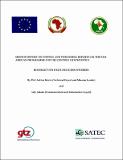Booklet on PACE success stories.

(en=English; ar=Arabic; fr=French; pt=Portuguese)
Authors
African Union Inter-African Bureau for Animal Resources
AU-IBAR
Type
ReportItem Usage Stats
170
views
views
23
downloads
downloads
Abstract
When Rinderpest was introduced to Africa in the late 19th Century, the pandemic killed up to
90% of cattle and other susceptible wildlife species. The disease has plagued the African
continent since then due to the presence of large numbers of domestic and wild animals, the
inadequacy of veterinary services, nomadic husbandry practices and insecurity. Concerted
action to eradicate the disease, commencing with the "Joint Project 15", implemented by the
Organization of African Unity/ Interafrican Bureau for Animal Resources (OAU/IBAR) in
the 1960s and 1970s followed by the Pan African Rinderpest Campaign (PARC) in the mid
1980s and the Pan African Control of Epizootics (PACE) in the late 1990s, succeeded in
eradicating Rinderpest from most of Africa with the exception of the so called mild strain of
the virus in the "Somali Eco-system", an area of land that encompass South East Ethiopia,
North East Kenya and Southern Somalia.
The PACE Programme, which is in its final phase (November 1999 to February 2007) was
conceptualized to build on the headway made by the Pan African Rinderpest Eradication
Programme (PARC) (1986 to 1999) in the campaign against Rinderpest. The PARC has lasted
from 1986 to 1999 and has been co-financed by the European Community (EC). PARC has been
a follow up of the Joint project 15 (JP15) (1962 to 1976) also aimed at fighting the Rinderpest in
Africa. All these actions have already done a great deal to improve health security by combating
Rinderpest, one of the most devastating contagious diseases of cattle.
Taking advantage of PARC's achievements, a fundamental objective of PACE was to continue
the establishment of effective surveillance systems for animal diseases in 30 countries involved
in the programme. Such surveillance is essential for an effective veterinary service in any
country as is indicated by the requirement for adequate disease reporting (OIE, 2002). Thus
without effective surveillance for important animal diseases, particularly those that affect trade
in livestock and livestock products, human health or the economics of animal production, a
veterinary service will not be considered reliable. Increasingly, the World Organization of
Animal Health (OIE) provided a mechanism whereby member countries may apply for
recognition of freedom from specific diseases, such as Rinderpest, foot and mouth disease
(FMD), contagious bovine pleuro-pneumonia (CBPP) and bovine spongiform encephalopathy
(BSE). In order to apply successfully it is necessary for the country concerned to demonstrate,
irrespective of the requirement for individual diseases, that it has an effective veterinary service
which, as already indicated, includes an effective surveillance system. Consequently, all
applications for freedom from disease need to be supported by surveillance data. For this
reason, in the context of globalisation the establishment of surveillance system has become a
priority for veterinary services in countries, which would like to take part in the international
trade of livestock and animal by-products.
In particular, Rinderpest eradication is a global objective and the African Union / Inter African
Bureau for Animal Resources (AU / IBAR), through the Pan African Programme for the Control
of Epizootics (PACE) has been for 7 years spearheading its eradication in the African continent.